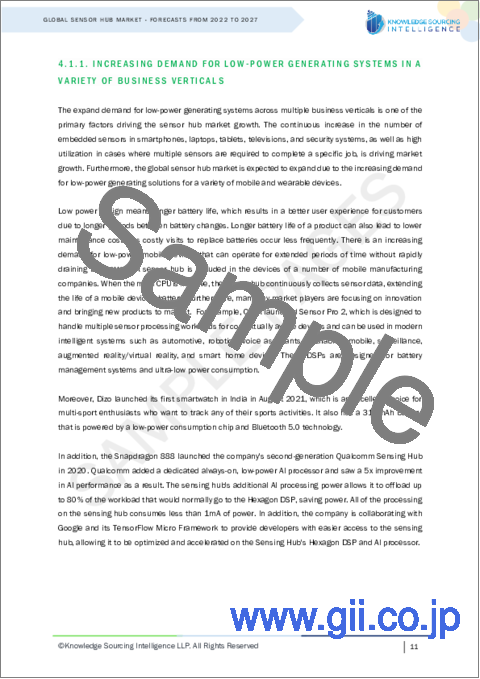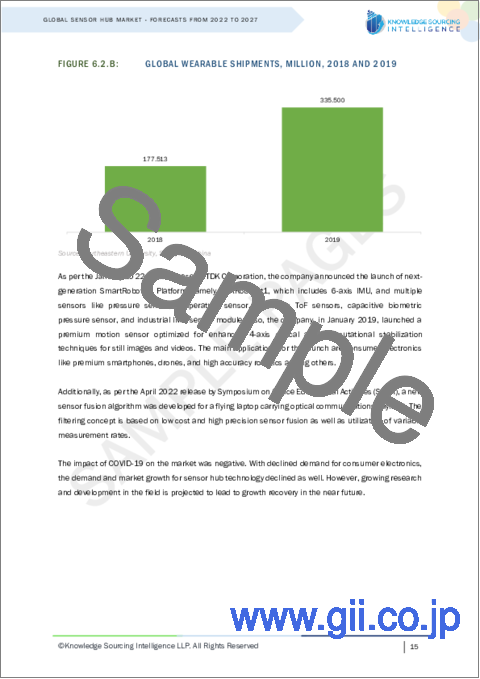|
|
市場調査レポート
商品コード
1086981
センサーハブの世界市場予測(2022年~2027年)Global Sensor Hub Market - Forecasts from 2022 to 2027 |
||||||
|
● お客様のご希望に応じて、既存データの加工や未掲載情報(例:国別セグメント)の追加などの対応が可能です。 詳細はお問い合わせください。 |
|||||||
| センサーハブの世界市場予測(2022年~2027年) |
|
出版日: 2022年04月08日
発行: Knowledge Sourcing Intelligence
ページ情報: 英文 115 Pages
納期: 即日から翌営業日
|
- 全表示
- 概要
- 目次
世界のセンサーハブの市場規模は、2020年の192億8,200万米ドルから、2027年には660億800万米ドルに達し、予測期間中のCAGRで19.22%の成長が予測されています。
センサーハブ市場の成長を促進する主な要因の1つは、多数の事業分野にまたがる低電力生成システムに対する需要の増加です。スマートフォン、ノートパソコン、タブレット、テレビ、セキュリティシステムなどに搭載される組み込みセンサーの数が継続的に増加し、特定の作業を完了するために多数のセンサーが必要となるケースでの利用率が高いことが、市場の拡大を加速させています。
当レポートでは、世界のセンサーハブ市場を調査しており、市場の概要、市場の促進要因や抑制要因、プロセッサータイプ・エンドユーザー・地域別の分析、競合情勢、企業プロファイルなどを提供しています。
目次
第1章 イントロダクション
- 市場の定義
- 市場セグメンテーション
第2章 調査手法
- 調査データ
- 前提条件
第3章 エグゼクティブサマリー
- 調査ハイライト
第4章 市場力学
- 市場促進要因
- 市場抑制要因
- ポーターのファイブフォース分析
- 売り手の交渉力
- 買い手の交渉力
- 代替品の脅威
- 新規参入業者の脅威
- 業界における競合情勢
- 業界のバリューチェーン分析
第5章 世界のセンサーハブ市場:プロセッサータイプ別
- イントロダクション
- アプリケーションセンサープロセッサー
- ディスクリートセンサープロセッサー
- センサー統合型マイクロコントローラー
- その他
第6章 世界のセンサーハブ市場:エンドユーザー別
- イントロダクション
- 家電
- 自動車
- 工業
- 軍事
- 医療
- 通信
- その他
第7章 世界のセンサーハブ市場:地域別
- イントロダクション
- 北米
- 米国
- カナダ
- メキシコ
- 南米
- ブラジル
- アルゼンチン
- その他
- 欧州
- 英国
- ドイツ
- フランス
- イタリア
- その他
- 中東・アフリカ
- サウジアラビア
- イスラエル
- その他
- アジア太平洋地域
- 中国
- 日本
- インド
- 韓国
- インドネシア
- タイ
- 台湾
- その他
第8章 競合環境と分析
- 主要企業と戦略分析
- 新興企業と市場の有利性
- 合併、買収、合意、およびコラボレーション
- ベンダー競争力マトリックス
第9章 企業プロファイル
- Texas Instruments Inc.
- STMicroelectronics N.V.
- NXP Semiconductors N.V
- Invensense, Inc.
- Rohm Co. Ltd.
- Robert Bosch GmbH
- Infineon Technologies AG
- LAPIS Semiconductor Co. Ltd
- Microchip Technology Inc.
- CEVA
- Analog Devices Inc.
- Intel
The global sensor hub market is projected to grow at a CAGR of 19.22% during the forecast period to reach US$66.008 billion by 2027, from US$19.282 billion in 2020. A sensor hub is a multi-sensor connection point that uses a digital signal processor, multipoint control unit, or coprocessor to compile and process data from all of the sources. This permits sensor data to be collected and processed with less strain on computer resources, resulting in improved performance, lower battery consumption, and more CPU time. Sensor hubs are operated when several sensors are required to complete a task and there is a high demand for resources and efficiency. For better system performance, an increasing amount of data from different sensors must be fused in the system. These complicated sensor fusion algorithms are operated by the sensor hub, which provides maximum flexibility for system operation.
One of the primary factors driving the growth of the sensor hub market is the increase in demand for low-power generating systems spanning numerous business verticals. The continuous increase in the number of embedded sensors in smartphones, laptops, tablets, televisions, and security systems, as well as high utilization in cases where numerous sensors are required to complete a certain job, is accelerating market expansion. The increased use of 6-axis and 9-axis sensor solutions or sensor fusion within devices, as well as the increase in the number of manufacturing companies embedding a sensor hub in their mobile devices to assist in continuously collecting sensor data while keeping the main processor idle and thus saving the battery life of a mobile device, all have an impact on the market. Furthermore, rising industrialization and urbanization, the rise in demand for new technologies, and the expansion of the electronic devices sector have had a beneficial impact on the sensor hub market. Furthermore, in the projected period, improvements in consumer electronics end-use applications and wearable devices provide profitable prospects for market players.
On the other hand, market growth is projected to be hampered by difficulties in troubleshooting field issues due to the lack of a direct interface between the sensor hub and the application processor. In the projected period, technical complexity in sensor hub deployment is expected to create a problem for the sensor hub market's growth. Advanced technical expertise is required for the successful implementation of sensor hubs in goods. For the sensor hub industry to flourish, more focus must be placed on the convenience of integrating sensors with microcontrollers as well as entire sensor hub systems.
Key Developments
In March 2021, B-Secur and IoT business Maxim Integrated Products Inc. released a novel ultra-low power health sensor hub for monitoring heartbeat biometrics. CEVA, Inc. announced the new SensPro DSP line, a hub for DSP and AI processing workloads associated with a variety of sensors such as radar, Time-of-Flight, LiDAR, microphones, cameras, and inertial measurement units in January 2021.
By processor type, the global sensor hub market can be segmented into sensor integrated microcontrollers, discrete sensor processors, application sensor processor, and others. The sensor hub industry is likely to be dominated by the discrete sensor processors segment in the projected period owing to the processor type's greater power efficiency and the widespread use of separate sensor processor hubs in wearable devices.
By end-users, the global sensor hub market can be segmented into consumer electronics, industrial, automotive, healthcare, military, telecommunications, and others. The consumer electronics segment dominates the market. The widespread usage of sensor hubs in smartphones, smart TVs, tablets, and gaming consoles is responsible for this growth. Sensors are used in all of these devices for a variety of tasks, including gesture recognition, navigation, picture stabilization, motion-based gaming, and health monitoring. Demand for wearables is rising significantly in the healthcare industry as well.
By geography, the global sensor hub market can be segmented into the Asia Pacific, North America, the Middle East, Africa, South America, and Europe. Due to increased investment in the creation of new sensor hubs and internet of things related technology by various significant firms, North America and Europe are likely to lead the sensor hub market. However, because of the increased investment in smart city projects and growing demand for consumer products such as smart TVs, gaming consoles, tablets, smartphones, and wearable devices, the sensor hub market is expected to rise at a high rate in emerging areas such as Asia-Pacific. The sensor hub market in the Asia Pacific region is predicted to increase due to rising electronic device manufacturing sectors and increasing digitalization. Over the projected period, the worldwide sensor hub market is expected to grow at a modest rate in Latin America, the Middle East, and Africa.
COVID-19 Insights
The COVID-19 epidemic impacted the global sensor hub market significantly. Changes in consumer behavior, government policies, and organizational agendas open up a slew of chances to use the Internet of Things to develop innovative solutions in front of the new normal. Remote work and telemedicine, are expected to stick around long after the pandemic has passed. Increased demand in end-user industries such as consumer electronics and wearables are expected to have a favorable impact on the sensor hub market.
Market Segmentation:
- By Processor Type
Application Sensor Processor
Discrete Sensor Processor
Sensor Integrated Microcontroller
Others
- By End-Users
Consumer Electronics
Automotive
Industrial
Military
Healthcare
Telecommunications
Others
- By Geography
North America
- USA
- Canada
- Mexico
South America
- Brazil
- Argentina
- Others
Europe
- United Kingdom
- Germany
- France
- Italy
- Others
Middle East and Africa
- Saudi Arabia
- Israel
- Others
Asia Pacific
- China
- Japan
- India
- South Korea
- Indonesia
- Thailand
- Taiwan
- Others
TABLE OF CONTENTS
1. INTRODUCTION
- 1.1. Market Definition
- 1.2. Market Segmentation
2. RESEARCH METHODOLOGY
- 2.1. Research Data
- 2.2. Assumptions
3. EXECUTIVE SUMMARY
- 3.1. Research Highlight
4. MARKET DYNAMICS
- 4.1. Market Drivers
- 4.2. Market Restraints
- 4.3. Porter's Five Forces Analysis
- 4.3.1. Bargaining Power of Suppliers
- 4.3.2. Bargaining Powers of Buyers
- 4.3.3. Threat of Substitutes
- 4.3.4. Threat of New Entrants
- 4.3.5. Competitive Rivalry in Industry
- 4.4. Industry Value Chain Analysis
5. GLOBAL SENSOR HUB MARKET, BY PROCESSOR TYPE
- 5.1. Introduction
- 5.2. Application Sensor Processor
- 5.3. Discrete Sensor Processor
- 5.4. Sensor Integrated Microcontroller
- 5.5. Others
6. GLOBAL SENSOR HUB MARKET, BY END-USERS
- 6.1. Introduction
- 6.2. Consumer Electronics
- 6.3. Automotive
- 6.4. Industrial
- 6.5. Military
- 6.6. Healthcare
- 6.7. Telecommunications
- 6.8. Others
7. GLOBAL SENSOR HUB MARKET, BY GEOGRAPHY
- 7.1. Introduction
- 7.2. North America
- 7.2.1. United States
- 7.2.2. Canada
- 7.2.3. Mexico
- 7.3. South America
- 7.3.1. Brazil
- 7.3.2. Argentina
- 7.3.3. Others
- 7.4. Europe
- 7.4.1. United Kingdom
- 7.4.2. Germany
- 7.4.3. France
- 7.4.4. Italy
- 7.4.5. Others
- 7.5. Middle East and Africa
- 7.5.1. Saudi Arabia
- 7.5.2. Israel
- 7.5.3. Others
- 7.6. Asia Pacific
- 7.6.1. China
- 7.6.2. Japan
- 7.6.3. India
- 7.6.4. South Korea
- 7.6.5. Indonesia
- 7.6.6. Thailand
- 7.6.7. Taiwan
- 7.6.8. Others
8. COMPETITIVE ENVIRONMENT AND ANALYSIS
- 8.1. Major Players and Strategy Analysis
- 8.2. Emerging Players and Market Lucrativeness
- 8.3. Mergers, Acquisition, Agreements, and Collaborations
- 8.4. Vendor Competitiveness Matrix
9. COMPANY PROFILES
- 9.1. Texas Instruments Inc.
- 9.2. STMicroelectronics N.V.
- 9.3. NXP Semiconductors N.V
- 9.4. Invensense, Inc.,
- 9.5. Rohm Co. Ltd.,
- 9.6. Robert Bosch GmbH
- 9.7. Infineon Technologies AG
- 9.8. LAPIS Semiconductor Co. Ltd
- 9.9. Microchip Technology Inc.
- 9.10. CEVA
- 9.11. Analog Devices Inc.
- 9.12. Intel




